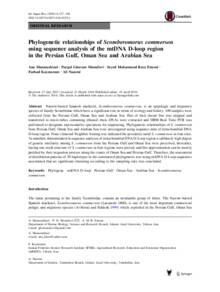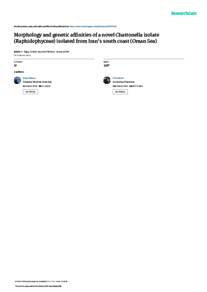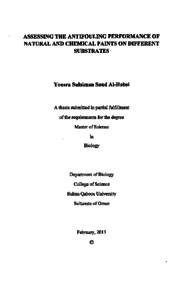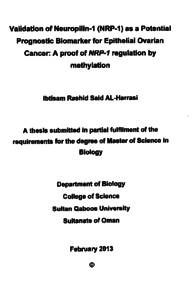Document
Detection and characterization of different begomoviruses and associated DNA satellites from selected host plants in Oman.
Publisher
Sultan Qaboos University.
Gregorian
2020
Language
English
English abstract
Chili leaf curl virus (ChLCV) and Tomato leaf curl virus (TYLCV) are members of
Genus Begomovirus (family Geminiviridae) which contains single–stranded DNA
viruses transmitted exclusively by the whitefly (Bemisia tabaci). An analysis of the
genetic diversity of begomovirus isolates across Oman was conducted. A total of
twenty five samples were collected from different governorates (Muscat, Musandam,
Ad-Dakhilia, Al-Batinah South, Dhofar and Ash-Sharqiah South) and were tested for
begomovirus, betasatellite and alphasatellite molecules. Rolling circle amplification
(RCA) was used for the detection of full-length begomoviruses, while polymerase
chain reaction (PCR) was used for the detection of betasatellite and alphasatellite. The
complete nucleotide sequence identity of the begomoviruses, alphasatellite and
betasatellite were done in their entirety.
Analysis of these sequences showed that ChLCV and TYLCV are the most prevalent
causal agents of leaf curl disease in Oman and show phylogeographic segregation.
Moreover, ChLCV was characterized from a new weed host Senna italica Miller
located near an infected tomato field. Further it was found that the amplified ChLCV
and TYLCV exhibited the highest nucleotide identity with the previously reported
ChLCV and TYLCV strains infecting tomato in Oman. Although, earlier studies have
indicated that TYLCV is the most prevalent virus infecting mainly tomato crop in
Oman, this study shows that ChLCV has been increasing its host range into diverse
host plants including weeds as well as increasing its distribution into diverse
geographical areas. Furthermore, phylogenetic and other molecular analyses showed
that 88% of tested plant samples with begomovirus-like symptoms were also
associated with tomato leaf curl betasatellite. In addition, the occurrence of
alphasatellite is very rare, and only one okra leaf Oman alphsatellite was also
detected.
Arabic abstract
يعد فيروس )ChLCV )وفيروس )TYLCV )من أنواع البيجوموفيرس التي تنتمي لعائلة الجرميفيريديا والتي
تحتوي على فيروسات DNA أحادية السلسلة التي تنتقل حصريًا بواسطة الذبابة البيضاء )tabaci Bemisia .)
أجري تحليل للتنوع الوراثي لعزالت البيجوموفيروس من جميع أنحاء السلطنة. تم جمع 25 عينة من محافظات
ا عن جزيئات
مختلفة )مسقط ، مسندم ، الداخلية ، جنوب الباطنة ، ظفار وجنوب الشرقية( وتم اختبارها بحثً
البيجوموفيرس، االلفا ساتاليت والبيتاساتاليت، تم استخدام تضخيم دائرة التدحرج )RCA )للكشف عن
البيجوموفيرس و استخدم تفاعل سلسلة البلمرة )PCR )للكشف عن االلفاساتاليت والبيتاساتاليت، وتم في الوقت
ذاته الكشف عن التسلسل النووي الكامل لهذه الجزيئات.
أظهر تحليل هذه التسلسالت أن ChLCV و TYLCV هما المسببان األكثر شيو ًعا لمرض تجعد األوراق في
ُعمان. عالوة على ذلك ، وجد ChLCV الول مرة في نوع من انواع الحشائش italica Senna يقع بالقرب
من حقل طماطم مصاب. عالوة على ذلك ، وجد أن تضخيم الحمض النووي ل ChLCV و TYLCV أظهر
ا على الطماطم في السلطنة. على الرغم من
وجود تشابه كبير مع سالالت ChLCV و TYLCV المسجلة سابقً
أن الدراسات السابقة قد أشارت إلى أن TYLCV هو أكثر الفيروسات انتشا ًرا في إصابة محصول الطماطم في
ُعمان ، إال أن هذه الدراسة أظهرت أن ChLCV قد زاد من انتشاره في النباتات المضيفة المتنوعة بما في ذلك
الحشائش وكذلك زاد انتشاره في مناطق جغرافية متنوعة. عالوة على ذلك، أظهرت التحاليل الجينية وغيرها من
التحاليل الجزيئية أن 88 ٪من عينات النباتات المختبرة التي ظهرت عليها أعراض تشبه أعراض
البيجوموفيروس ارتبطت أي ًضا بالبيتاساتاليت الموجودة في أوراق الطماطم. باإلضافة إلى ذلك ، فإن وجود
االلفاساتااليت نادر للغاية، ولم يتم اكتشافه سوى في ورقة البامية.
تحتوي على فيروسات DNA أحادية السلسلة التي تنتقل حصريًا بواسطة الذبابة البيضاء )tabaci Bemisia .)
أجري تحليل للتنوع الوراثي لعزالت البيجوموفيروس من جميع أنحاء السلطنة. تم جمع 25 عينة من محافظات
ا عن جزيئات
مختلفة )مسقط ، مسندم ، الداخلية ، جنوب الباطنة ، ظفار وجنوب الشرقية( وتم اختبارها بحثً
البيجوموفيرس، االلفا ساتاليت والبيتاساتاليت، تم استخدام تضخيم دائرة التدحرج )RCA )للكشف عن
البيجوموفيرس و استخدم تفاعل سلسلة البلمرة )PCR )للكشف عن االلفاساتاليت والبيتاساتاليت، وتم في الوقت
ذاته الكشف عن التسلسل النووي الكامل لهذه الجزيئات.
أظهر تحليل هذه التسلسالت أن ChLCV و TYLCV هما المسببان األكثر شيو ًعا لمرض تجعد األوراق في
ُعمان. عالوة على ذلك ، وجد ChLCV الول مرة في نوع من انواع الحشائش italica Senna يقع بالقرب
من حقل طماطم مصاب. عالوة على ذلك ، وجد أن تضخيم الحمض النووي ل ChLCV و TYLCV أظهر
ا على الطماطم في السلطنة. على الرغم من
وجود تشابه كبير مع سالالت ChLCV و TYLCV المسجلة سابقً
أن الدراسات السابقة قد أشارت إلى أن TYLCV هو أكثر الفيروسات انتشا ًرا في إصابة محصول الطماطم في
ُعمان ، إال أن هذه الدراسة أظهرت أن ChLCV قد زاد من انتشاره في النباتات المضيفة المتنوعة بما في ذلك
الحشائش وكذلك زاد انتشاره في مناطق جغرافية متنوعة. عالوة على ذلك، أظهرت التحاليل الجينية وغيرها من
التحاليل الجزيئية أن 88 ٪من عينات النباتات المختبرة التي ظهرت عليها أعراض تشبه أعراض
البيجوموفيروس ارتبطت أي ًضا بالبيتاساتاليت الموجودة في أوراق الطماطم. باإلضافة إلى ذلك ، فإن وجود
االلفاساتااليت نادر للغاية، ولم يتم اكتشافه سوى في ورقة البامية.
Member of
Resource URL
Same Subject



